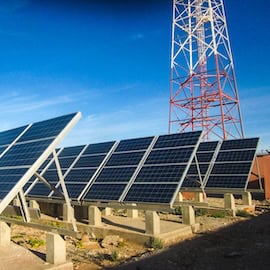Reliable electricity and digital connectivity are fundamental to economic growth, social inclusion and sustainable development. Sub-Saharan Africa has the highest energy access and connectivity gap in the world: Almost 600 million people in the region live without access to electricity, representing over 80% of the world’s unelectrified population. In terms of mobile internet, 160 million people in sub-Saharan Africa remain unconnected because they live in areas without network coverage. An additional 710 million live within coverage areas but are not using mobile internet — a phenomenon known as the “usage gap,” which is driven by barriers such as affordability, limited digital literacy, lack of devices and insufficient locally relevant content. Closing the usage gap could add $700 billion to the region’s GDP between 2024 and 2030, while also reducing poverty and inequality, and improving education, healthcare and climate action.
Together, these figures paint a stark picture of Africa’s energy and digital divide — one that threatens to leave much of the continent behind in the global race toward inclusive, tech-enabled development.
Addressing these gaps requires a new approach that recognises the interdependence of energy and digital access, and prioritises integrated investments that bring both electricity and internet to underserved communities. Expanding energy access and bridging the digital divide are not separate goals — they are intrinsically connected. Telecom networks cannot operate without reliable power, and energy distribution can be optimised with the help of digital technologies.
Recognising and leveraging this synergy is at the heart of what I call “connected power”: a development approach that aligns electrification and connectivity efforts to maximise impact. Embracing this model could unlock transformative opportunities for rural communities, national economies and the continent as a whole.
Why Energy Access Is a Prerequisite for Digital Inclusion
Digital technologies are rapidly reshaping economies and societies worldwide. Yet for millions across Africa, even basic connectivity remains out of reach, not because of a lack of demand, but due to fundamental infrastructure barriers. A key barrier is the lack of reliable energy supply. Telecom towers and mobile networks depend on a reliable, high-quality power supply to function effectively. In Africa, around a third of telecom base stations are either entirely off-grid or located in areas with weak and unreliable electricity access, forcing them to rely on expensive and polluting diesel generators.
Energy costs represent around 30% of operating expenses for base stations in urban areas, but these costs rise by 35-40% in rural and remote regions largely due to the use of diesel to compensate for patchy or non-existent grids. These elevated costs make rural expansion less commercially attractive, undermining the business case for reaching underserved populations.
This creates a self-reinforcing loop of exclusion: Without reliable energy, digital infrastructure remains underdeveloped; without connectivity, communities are cut off from critical services such as mobile payments, digital health solutions, online education and digital ID systems. Simply put, digital inclusion is only as strong as the energy systems that underpin it.
Breaking the Cycle: Integrated Infrastructure Planning
As a result, there is an urgent need for integrated infrastructure planning. By aligning energy and telecom investments, we can unlock economies of scale, reduce costs and reach communities more efficiently.
One of the most effective strategies is to position telecom towers as anchor customers for energy projects, whether through grid extensions or decentralised mini-grids. These towers provide:
- Stable, long-term demand for electricity, improving the financial viability of energy projects;
- Predictable revenues for utilities or mini-grid developers, reducing investment risk; and
- A platform for expanding power access to surrounding households, schools and small businesses.
This approach is already being implemented in various African countries. For example, where utility-led grid extension is viable, long-term power purchase agreements between electric utilities and independent tower companies (towercos) or mobile operators help reduce financial risk and strengthen the investment case for rural electrification. Such partnerships also benefit utilities, which often depend on digital networks for monitoring, billing and operations.
In areas where grid access is impractical, solar-powered mini-grids can provide reliable electricity to telecom sites while also powering the broader community. These models avoid the high cost and volatility of diesel fuel and contribute to environmental sustainability.
The Role of Renewable Energy and TowerCOS
As Africa’s energy and telecom sectors increasingly converge, towercos play a pivotal role in advancing both electrification and digital access. These companies operate thousands of telecom towers across the continent, providing the essential passive infrastructure that mobile operators rely on. Many are already deploying sustainable power solutions, such as solar, batteries and hybrid systems, to keep mobile networks running in remote and underserved areas, effectively bridging gaps in both connectivity and energy access.
Towercos’ contributions to the energy sector include:
- Investing in renewable energy infrastructure, particularly solar and hybrid systems;
- Enhancing energy efficiency through technology upgrades and smart power management systems;
- Serving as anchor tenants for mini-grid providers, enabling the financial viability of energy projects in off-grid rural areas; and
- Sharing best practices and technical expertise with governments, utilities and energy providers.
Importantly, towercos are uniquely positioned to act as development catalysts: Their consistent demand for power can de-risk rural energy investments, and their infrastructure footprint can be leveraged to extend digital and electrical services to nearby communities.
AcceleratING Integrated Access: THE ROLE OF POLICYMAKERS AND DFIS
However, while private sector innovation is essential, government-led policy reform is also crucial to scaling integrated energy and digital infrastructure. Governments must lead in creating regulatory environments that support co-investment and coordinated planning — particularly around grid expansion and renewable deployment.
Enabling policies in these areas will not only lower the cost of powering telecom networks but also accelerate connectivity in underserved regions. Key policy recommendations proposed by the GSMA and others include:
- Establishing a shared public platform: Government agencies can launch online portals that provide data on existing telecom coverage and planned electrification projects. This would improve coordination, reduce duplication and optimise infrastructure investments.
- Removing import duties on green energy equipment: Uniform tax exemptions for solar panels, batteries and inverters would accelerate the deployment of clean energy solutions for telecom and rural power projects.
- Encouraging net metering policies: Allowing mobile operators to feed surplus energy back into the grid would enhance return on investment and incentivise distributed generation.
- Offering green fiscal tools: Providing subsidies or tax incentives for cleaner energy solutions would help lower investment and operational costs.
- Designating telecom infrastructure as critical national infrastructure: This would ensure prioritised access to electricity for these companies, and streamline permitting for energy upgrades.
- Creating free zones for renewable energy development: Designating special economic zones for this purpose would allow for the rapid deployment of solar or wind power projects for telecom and community use.
- Incentivising financial institutions to develop innovative financing: Development finance institutions (DFIs) and central banks can encourage the use of blended finance, risk guarantees and tailored instruments that attract more capital into integrated infrastructure.
DFIs can complement these government efforts by offering technical assistance, financial instruments, and incentives that help de-risk investments and make projects more bankable — thereby attracting private capital and accelerating implementation. To ensure that any momentum in the policy space delivers lasting results, DFIs and other funders should focus on integrated investments that deliver both electrification and digital connectivity. This can be achieved by:
- Conditioning funding on digital integration: Encourage recipient governments to incorporate broadband access targets into rural electrification strategies.
- Supporting blended finance for dual-purpose infrastructure: Co-finance projects that simultaneously deliver electricity and telecom coverage.
- Promoting national strategies that recognise synergies: Back planning frameworks that explicitly link digital connectivity to energy development.
- Facilitating public-private dialogue: Create forums where governments, towercos, mobile operators and energy providers can co-create investment strategies.
By adopting this integrated approach, funders can significantly increase the impact of their capital — delivering not only energy access, but also broader development outcomes in education, healthcare, commerce and governance.
Connected Power: A Defining Opportunity for Africa’s Future
Digital transformation is central to Africa’s development goals, from the African Union’s Agenda 2063 to national broadband strategies. Yet without reliable power, digital technologies cannot reach the communities that need them most. We must act faster and smarter. At the current pace, it could take 30 years to close the continent’s mobile usage gap — and in the meantime, African countries will continue to miss out on a valuable driver of economic growth, since a 10% increase in mobile broadband penetration can raise GDP per capita by 2.5%. That alone is a powerful reason to ensure every electrification project has a connectivity component.
Africa now faces a unique opportunity to take bold action on this front. At the historic Mission 300 Africa Energy Summit held earlier this year in Dar es Salaam, heads of state and energy ministers, DFIs, private sector leaders, and non-profits from across the region and around the world came together to confront the pressing challenge of energy poverty in Africa. The summit marked a pivotal moment in the continent’s electrification journey, galvanising a shared commitment to connect 300 million people to electricity by 2030 and unlock the potential for inclusive growth and poverty reduction across the region. With over $50 billion in funding commitments secured, the challenge now is to transform ambition into impact by translating these pledges into integrated solutions that connect people — not just to electricity, but to economic opportunity.
As Dr. Akinwumi Adesina, President of the African Development Bank, said at the Mission 300 Summit: “We can do megawatts of talk all we want, but it’s going to be the megawatts of power we deliver that make this an action-driven summit.” It’s time those megawatts also delivered megabytes — and with them, the full promise of digital inclusion.
Africa stands at a unique crossroads. The capital is being mobilised. The partnerships are forming. The solutions exist. What’s needed now is the resolve to align energy and digital priorities, and to scale the integrated investments that can transform communities.
Connected power is more than a concept — it’s a development imperative. By uniting energy access with digital connectivity, we can empower millions, unlock economic growth and build a truly inclusive, sustainable future for Africa.
Let’s not leave anyone in the dark — or offline.
Ravi Suchak is Group Head of External Affairs, Sustainability and Public Policy at Helios Towers.
Photo credit: jbdodane
Publisher: Source link






